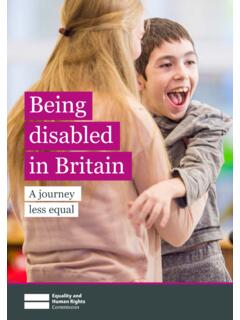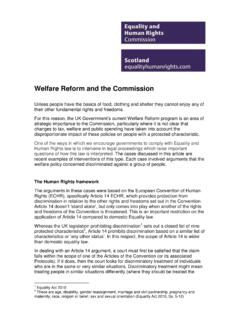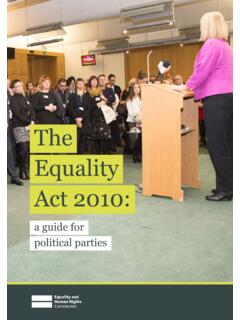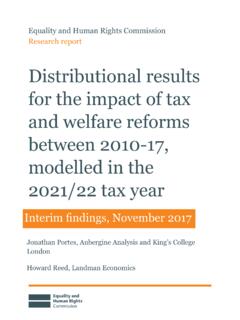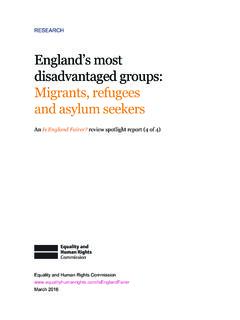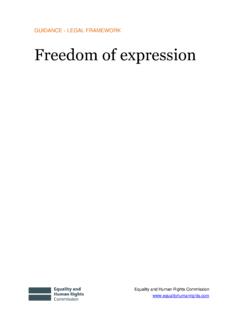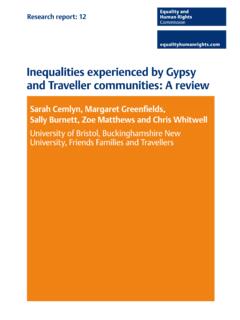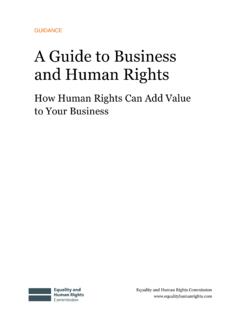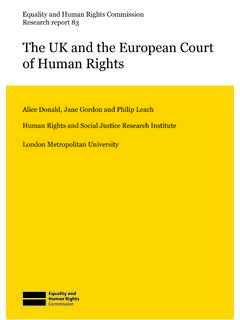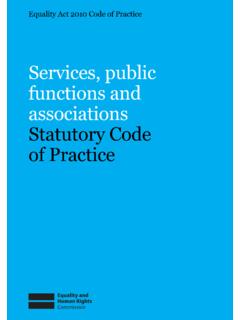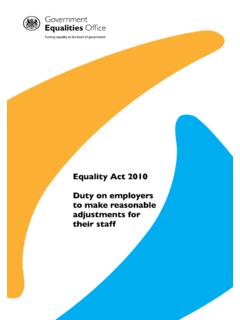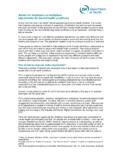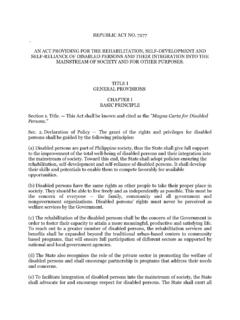Transcription of Equality Act 2010
1 1 Equality Act 2010 Handbook for advisors22 Contents Introduction 3 Section A Protected characteristics 5 Section B Unlawful (and lawful) conduct 10 Section C Application of Equality law in different sectors 17 Section D The Public Sector Equality Duty 43 Section E Equality and Human Rights Commission: its role and legal powers 47 List of abbreviations 50 Endnotes 51 Contacts 52 3 IntroductionThe aim of this handbook is to provide a brief overview of the Equality Act 2010 and to act as a reference guide. This chapter is not designed to be a comprehensive summary of Equality law.
2 Instead advisors are encouraged to use this as a starting point to direct further should bear in mind that clients may not initially present their problem as a discrimination case but nonetheless may have a claim under the Equality Act 2010. This protects against six forms of prohibited conduct because of nine protected characteristics in a range of contexts: services, public functions, premises, work, education, and associations. Advisors should be aware that although there may be general rules, a number of exceptions apply. Not all discrimination is handbook only applies to the application of Equality law in Scotland. This handbook is up to date, and links are correct, as at 31 March 2017, but advisors should ensure that they check for any changes in the law which may be of relevance to their query.
3 If you have a query about a discrimination law issue arising in a case, the Equality and Human Rights Commission may be able to assist with second-tier advice. The Commission cannot give advice to individuals but more information about the role of the Commission and how to contact the legal team can be found in section Checklist for advisors: Has the person suffered a disadvantage? Is any disadvantage because of a protected characteristic? Does any potential discrimination fall under an exception? Is there a justification applicable? What court or tribunal will it be raised in and what remedies are available? What is the time limit and when did it commence running?
4 155 Section A Protected characteristics6A Age (s. 5)The Act does not define an age group; it could be narrow or wide. It could be relative, for example younger than me , and can be a particular age. Disability (s. 6)A person has a disability if he or she has a physical or mental impairment that has a substantial, long-term adverse effect on his/her ability to carry out normal day-to-day are some general points to consider: Physical or mental impairment includes sensory impairments. Substantial effect need only be more than minor or trivial. Long-term means that it has lasted or is likely to last at least 12 months, or for the rest of the person s life.
5 Progressive conditions are treated as a disability from the moment there is any impairment that has some adverse effect on ability to carry out day-to-day activities, provided the future adverse effect is likely to become substantial. There is no exhaustive list of day-to-day activities but normal work-related activities are included, although highly specialised work activities are not. The effects of treatment are disregarded. Certain conditions such as HIV, cancer and multiple sclerosis are expressly A person certified by an ophthalmologist as blind, severely sight-impaired, sight-impaired or partially sighted has a deemed disability . Certain conditions are expressly excluded such as hay fever, a tendency to steal or to set more detail: see Schedule 1 as well as HM Government (2011), Guidance on matters to be taken into account in determining questions relating to the definition of disability , which is available at attachment_data/file/85010 and Equality Act 2010 (Disability) Regulations 2010, available at Gender reassignment (s.)
6 7)A person has this protected characteristic if he/she is proposing to undergo, is undergoing or has undergone a process, or part of a process for the purpose of reassigning the person s sex by changing physiological or other attributes of sex. This definition has a broad scope under the Act, as it refers to a personal process of moving from the birth sex to the preferred gender, rather than to a medical in the definition are people who propose to reassign their sex but have not yet started the process or have not completed it, as well as those who have been through the process in the past. It includes those undergoing medical gender reassignment, but this is not a Marriage and civil partnership (s.
7 8)This does not cover single people, divorcees, fianc s, cohabitees, and so on. Pregnancy and maternity (s. 17-18)The protected period in non-work cases ( ) covers the whole of a woman s pregnancy as well as 26 weeks following the birth (or stillbirth after more than 24 weeks of pregnancy).Section 18 applies to work cases where the protected period commences when a woman becomes pregnant and ends either two weeks after the end of the pregnancy or, if entitled to ordinary and additional maternity leave, at the end of that period or when she returns to work if that is earlier. Race (s. 9)This includes colour, nationality and ethnic or national origins. Religion or belief (s.
8 10)Religion includes any religion as well as a lack of religion. Belief means any religious or philosophical belief and includes a lack of Sex (s. 11)Sex includes reference to a man or to a woman. Sexual orientation (s. 12)This means a person s orientation towards people of the same sex, the opposite sex and either sex. It relates to feelings as well as actions, and manifestations such as appearance, dress, and social Section B Unlawful (and lawful) conductB11 Direct discrimination (s. 13)This occurs when a person treats another less favourably than they treat or would treat others because of a protected characteristic. The following points apply: It is lawful to treat a disabled person more favourably.
9 It includes discrimination by association (for example, where a friend or partner or carer has the characteristic). It includes discrimination by perception (for example, where the person does not actually hold the protected characteristic but is perceived to have it). It includes cases where the person does not, and is known not to have the characteristic, but nonetheless is treated less favourably because of it. Direct discrimination cannot be justified except in the case of age discrimination (see objective justification below). Indirect discrimination (s. 19)This occurs when an apparently neutral policy (provision, criterion or practice) is applied: that puts people sharing a protected characteristic at a particular disadvantage, and that puts the individual at that disadvantage.
10 Indirect discrimination can be justified if it is a proportionate means of achieving a legitimate aim (see objective justification below).B12 Discrimination arising from disability (s. 15)This occurs where a disabled person is treated unfavourably, where this treatment is because of something arising in consequence of the disabled person s disability, and where it cannot be shown that this treatment is a proportionate means of achieving a legitimate aim (see objective justification below). No comparator is required. There is no discrimination if it can be shown that the employer/service provider did not know and could not be expected to know that the disabled person had the disability.
